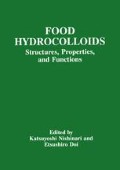Abstract
Complex Young’s modulus (E‘), compressive break-force (Ph) and curves of differencial scanning calorimetry (DSC) of gel Ian gum solution, with and without salt, were observed gellan gum gels as a function of salt and polymer concentration, Cs and Cg. E’ and Ph increased up to a certain Cs and then decreased with increasing Cs. The gelling and melting temperatures shifted to higher temperatures with increasing Cs and Cg. The sol-gel transition of samples was examined numerically by using zipper model approach. The introduction of cations increases the number of junction zones or zipper N and decreases the rotational freedom G of parallel links.
Access this chapter
Tax calculation will be finalised at checkout
Purchases are for personal use only
Preview
Unable to display preview. Download preview PDF.
References
M.A.O’Neill, R.R.Selvendran, and V.J.Morris, Structure of the Acidic Extracellular Gelling Polysaccharide Produced by Pseudomonas Elodea, Carbohydr. Res.,124:123(1983).
.Moritaka, H.Fukuba, K.Kumeno, N.Nakahama, and K.Nishinari, Effect of Monovalent and Divalent Cations on the Rheological Properties of Gellan Gels, Food Hydrocolloids, 4 (1991).
H.Moritaka, K.Nishinari, N.Nakahama, and H.Fukuba, Effects of Potassium Chloride and Sodium Chloride on the Thermal Properties of Gellan Gum Gels, Biosci. Biotech. Biochem, 56:4 (1992).
K.Nishinari, S.Koide, and K.Ogino, Synergistic Interaction of Xanthan Gum with Glucomannans and Galactomannans, J. Phys. France, 46:793 (1985).
H.Uedaira, and A.Ohsaka,“Water in Biological Systems,”Publisher, Kodansha, (1990)(in Japan).
J.E.Eldrige, and J.D.Ferry, Studies of the Cross-Linking Process in Gelatin Gels.I.Dependence of Melting Point on Concentration and Molecular Weight, J. Phys. Chem.,58:(1958).
K.Nishinari, S.Koide, P.A.Williams, and G.0.Phillips, A Zipper Model Approach to the Thermoreversible Gel-Sol Transition, J.Phys.France, 51:1759 (1990).
Author information
Authors and Affiliations
Editor information
Editors and Affiliations
Rights and permissions
Copyright information
© 1994 Springer Science+Business Media New York
About this chapter
Cite this chapter
Moritaka, H., Nishinari, K., Nakahama, N., Fukuba, H. (1994). Rheological and Thermal Properties of Gellan Gum Gels. In: Nishinari, K., Doi, E. (eds) Food Hydrocolloids. Springer, Boston, MA. https://doi.org/10.1007/978-1-4615-2486-1_11
Download citation
DOI: https://doi.org/10.1007/978-1-4615-2486-1_11
Publisher Name: Springer, Boston, MA
Print ISBN: 978-1-4613-6059-9
Online ISBN: 978-1-4615-2486-1
eBook Packages: Springer Book Archive

